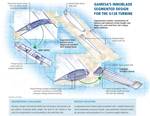Big blades, big innovations
In the process of designing its G128 wind turbine blade and the INNOBLADE segmented blade technology that simplifies its transport (see “Modular design eases big wind blade build,” under “Editor’s Picks,” at top right), Gamesa (Vizcaya, Spain) has introduced several innovative auxiliary technologies that reduce cost and simplify processing, particularly in the context of blade delivery and installation.
In the process of designing its G128 wind turbine blade and the INNOBLADE segmented blade technology that simplifies its transport (see “Modular design eases big wind blade build,” under “Editor’s Picks,” at top right), Gamesa (Vizcaya, Spain) has introduced several innovative auxiliary technologies that reduce cost and simplify processing, particularly in the context of blade delivery and installation. They incude the following:
MultiSmart Control System — Similar to a large mainsail on a sailboat, large blades generate greater power but also greater loads. The G128 features an independent variable pitch control system, which monitors data from strain sensors built into the blade laminate and adjusts each blade’s pitch in real time for optimized power output and minimized vibration. It provides up to 30 percent load reduction, alleviating the need for larger blade hub attachments and drive system components.
FlexiFit Crane — Gamesa’s proprietary compact, add-on crane, which couples to the nacelle, enables onsite assembly and servicing of structures without use of external structures or equipment. This eliminates the need to rent massive external cranes.
Fibramatic Automated Layup — Gamesa won the 2011 JEC Innovation Award in the Wind Energy category with partner MTorres (Pamplona, Spain), for the world’s first automated blade manufacturing process, featuring an automated gantry-type dry tape laying machine, automated infusion and automated assembly.
Related Content
-
Composites end markets: Batteries and fuel cells (2024)
As the number of battery and fuel cell electric vehicles (EVs) grows, so do the opportunities for composites in battery enclosures and components for fuel cells.
-
Drag-based wind turbine design for higher energy capture
Claiming significantly higher power generation capacity than traditional blades, Xenecore aims to scale up its current monocoque, fan-shaped wind blades, made via compression molded carbon fiber/epoxy with I-beam ribs and microsphere structural foam.
-
MingYang reveals 18-MW offshore wind turbine model with 140-meter-long blades
The Chinese wind turbine manufacturer surpasses its 16-MW platform, optimizes wind farm construction costs for 1-GW wind farms.













